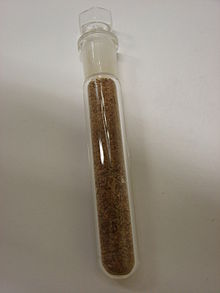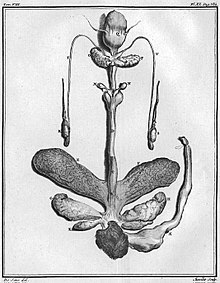Castoreum
![]()
This article describes a secretion of the beaver. For the medical practitioner of the same name, see Horst Bibergeil.
The castoreum or castor egg is a secretion from special paired and club-shaped sacs or pouches, castor pouches (misleadingly glandular sacs) under the pubis of the beaver (Castor fiber), which can be made into a powdery drug mass of the same name. They are not, however, glands in the histological sense, for they do not secrete. Castoreum also has various other names; geile glands, geile sacs, castor sacs, prepuce sacs, castor fiber, also geile or castor fiber. Sometimes it is just referred to as castor.
The musky scented secretion is formed in the body of the beaver and passed into the castor pouches, it consists of a complex mixture of chemical compounds probably formed from secondary metabolites of urine. The beaver uses the tallowy but not greasy, rather gummy, brownish and strongly pungent smelling secretion for grooming, its scent marking and for marking its territorial boundaries, as well as for distinguishing its conspecifics and family members.
The two pouches (misleadingly called preputial glands) of the beaver, weighing 25 to 250 grams and about the size of a hen's egg, which until the 16th century or longer were thought to be testicles or even sometimes in New France kidneys, and which in both sexes are located between the anus and the external sex organs and are surrounded by a brown-black wrinkled skin, are/were removed from the killed animal and smoke-dried. It can then also be stored for a longer period of time to improve its quality. The smell is similar to Valerian, leathery-animal-like, and the taste can be described as bitter, pungent and aromatic. In the USA there have been special beaver farms for some time, where the first stunned animals are "milked" and the precious secretion is squeezed out of the glands without killing the beavers.
The beaver has two other, smaller glands (oil sacs, fat pouches), these are, in contrast to the castor pouches, true holocrine glands (anal glands or perianal glands), from which the castor beaver fat (Axungia castorei) is obtained; it is greasy, with a faint, somewhat greasy odor. The majority of the secretion from these oil sacs serves to make the fur waterproof, similar to the brushing gland in birds. These secretions are colored by sex; grayish, with a paste-like consistency in females and yellowish-brown and liquid in males. In America, these smaller pouches are also known as oil stones.
The two different beaver bags are also generally referred to, misleadingly, by various authors as anal or anal glands or simply as oil bags.
The name "Castoreum" was formerly also used for the beaver testicle or sometimes, because of the strong aroma of the tubers, for the beaver root, probably the common Easter luce (Aristolochia clematitis) and (Aristolochia baetica).
Castoreum has nothing to do with castor beans or castor oil, as one might think. These are names taken from English for castor oil or the seeds of the miracle tree (castor beans).

Castoreum

bag system of the beaver, dark the big castor bags, below the smaller oil bags

Dried castor bags; German Pharmacy Museum, Heidelberg Castle
Chemical composition
24 of the numerous aromatic compounds contained in castoreum have now been identified as having a pheromone-like effect. Most strongly involved in this effect are the following four substances, two phenols and ketones each:
- 4-ethylphenol
- Brenzcatechin
- Acetophenone (acetylbenzene)
- 3-hydroxyacetophenone
In addition, five other ingredients were identified, which account for a smaller proportion of the effect:
- 4-methylcatechol
- 4-methoxyacetophenone
- 2-hydroxy-5-methoxybenzoic acid
- 3-hydroxybenzoic acid
- Salicylaldehyde
Use
Medicine
In medicine castoreum (or the oleum castoreum or castoreum oil produced from it or the castoreum latwerge diacastoreum and preparations from it) was used until the 19th century against gout as well as against convulsions, hysterical fits, nervousness and much more. Already in Greek-Roman antiquity, the substance, classified in humoral pathology as "hot and dry", was used against "cold and damp" diseases, including epileptic or epilepsy-like convulsions and against paralysis associated with speech disorders (as they occur in TIA and stroke). Its use as an aphrodisiac is based on the same humoral-pathological principle as its use as a remedy for paralysis. Castoreum was in great demand as a medicine and can be traced back to the 8th century in the German-speaking world. An actual medicinal effect is brought about by the salicylic acid it contains (ingredient of willow bark; the beaver's favourite food,→ acetylsalicylic acid). Today, castoreum has an economic significance only in homeopathy.
Castoreum was also used as a remedy against poisoning and was also a component of Theriak.
In the later Middle Ages in Western Europe, castoreum was mainly obtained from Asia Minor or Siberian beavers, because the stocks in Western Europe were already very low or even non-existent. It is available as Castoreum canadense (Canadian or American castoreum) and as the stronger smelling Castoreum sibiricum (Siberian or Russian castoreum) in pharmacies as tincture and powder.
Food
In the USA, castoreum is also approved by the Food and Drug Administration as a food additive and classified as harmless. There is a labelling obligation in the USA only as "natural flavouring", predominantly as vanilla, raspberry and strawberry flavouring.
Its use as a food additive is controversial, as beaver hunting in North America is said to have a detrimental effect on the beaver population (in Europe, beavers are protected under Annex II and IV of the Habitats Directive). Due to the only vague labelling obligation, it is not possible for vegans and vegetarians in the USA to clearly identify products containing castoreum.
In Sweden, castoreum is used to flavour "Bäverhojt", a traditional schnapps drink.
Perfumery
In perfumery, castoreum, which is said to have an aphrodisiac (eroticizing) effect, is a component of some perfumes. Similar substances are synthetically produced today and used in cosmetics. Here it serves as a fixative, i.e. as an ingredient that increases the binding and adhesive strength of the volatile odorants in the perfume composition. In concentrated form it smells unpleasant to repulsive, only in strong dilution it unfolds the fragrance notes appreciated by perfumers.
Questions and Answers
Q: What is castoreum?
A: Castoreum is the liquid that is released from the castor sacs of the beaver.
Q: What color is castoreum?
A: Castoreum is a yellowish liquid.
Q: What is castoreum mixed with?
A: Castoreum is mixed together with the beaver's urine.
Q: Why do beavers use castoreum?
A: Beavers use castoreum to mark their territory.
Q: How many castor sacs do beavers have?
A: Male and female beavers both have two castor sacs.
Q: Are the castor sacs glands?
A: No, the castor sacs are not glands.
Q: What are the castor sacs located between?
A: The castor sacs are located between the pelvis and the base of the tail, in two empty spaces under the skin.
Search within the encyclopedia